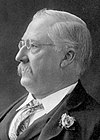1851 in Australia
| Decades: | |||||
|---|---|---|---|---|---|
| See also: | |||||
1851 in Australia was a watershed year. It saw the start of the
Victoria in July.[1] As a result of the Gold Rushes, the European population of Victoria increased from 97,489 in 1851 to 538,628 in 1861 and the population of NSW increased from 197,265 in 1851 to 350,860 in 1861.[2] Victoria became a self-governing colony. Sentiment in the eastern Australian colonies moved decisively against penal transportation leading to the end of transportation to Tasmania in 1853. Melbourne's major suburb/satellite city in the Dandenong Ranges, Belgrave
was first settled, making it the oldest town in the Dandenong Ranges.
Incumbents
Governors
Governors of the Australian colonies:
- Governor of New South Wales — Sir Charles Augustus FitzRoy
- Governor of South Australia — Sir Henry Fox Young
- Lieutenant-Governor of Tasmania — Sir William Denison
- Lieutenant-Governor of Victoria — Charles La Trobe; (office first formed in 1851)
- Governor of Western Australia as a Crown Colony — Captain Charles Fitzgerald.
Events
January–March
- 13 January — Governor-General of all Her Majesty's Australian possessions".[3] This position was a forerunner of the Governor-General of Australia.
- 6 February – The Wimmera and Dandenongdistricts. Approximately 12 people died, one million sheep and thousands of cattle were lost.
- 11 February — Victoriain the first inter-colonial cricket match.
- 12 February — Edward Hargraves finds gold near Bathurst, starting the first of many Australian gold rushes.
- 28 February – Formation of an Anti-Transportation Leaguefrom anti-transportation organisations in Victoria and Tasmania.
April – June
- 7 April — William Tom and John Lister.
- 10 April – The NSW Association for Preventing the Renewal of Transportation sends a petition to Queen Victoria.
- 28 May – The arrival of two convict ships, the Lady Kenneway with 249 male prisoners and Blackfriars with 260 female prisoners, further turns Tasmanian sentiment against transportation.
- 14 June – Gold found on the Turon River, New South Waleswhich proves to be the richest NSW goldfield.
July – September
- 1 July – Victoria becomes a separate colony
- 2 July – the Melbourne Chamber of Commerce elects their first chairman, William Westgarth, and deputy chairman, J.B.Were.
- 5 July — Victorian Gold Rush.
- 7 July – News of the discovery of Victoria is published in the Geelong Advertiser.
- 10 July – A public meeting in Hobart, one of the largest ever held in Tasmania, calls for the end of transportation.
- 14 July – Sir William Denison, Lieutenant-Governor of Tasmania writes to Earl Grey supporting a continuation of transportation.
- 15 July — Charles La Trobe appointed as first Lieutenant Governor of Victoria.
- 22 July – Northern NSW landholders write to Earl Grey calling for Northern NSW to become a separate colony with transportation of labour. They complain of a shortage of labour due to men going to the goldfields.
- 29 July – 1500 people attend a public meeting to oppose transportation organised by the Australasian League
- 2 August — Ballarat, Victoria, leading to the Victorian gold rush.
- 4 August – The Governor of Western Australia complains of receiving too many convicts as 300 ticket-of-leavemen arrive unexpectedly.
October – December
- 31 October – The New South Wales Legislative Council votes unanimously against transportation 'in any form what-so-ever, to any part of Her Majesty's Australian possessions'.
- 4 December – Charles LaTrobe forwards a Victorian Legislative Council motion passed unanimously opposing further transportation.
- 15 December – Between 14,000 and 20,000 gold miners attend an Miners Flagor 'Diggers Banner' was flown for the first time at this meeting.
Births

- )
- 26 March – Rosa Campbell Praed, novelist (d. 1935)
- )
- )
- )
- )
- )
- )
- 1 August – Sir Joseph Verco, physician and conchologist (d. 1933)
- Richard O'Connor, New South Wales politician and inaugural High Court justice (d. 1912)
- )
- 3 November – Norman Cameron, Tasmanian politician (d. 1931)
- )
- Unknown – George Darrell, playwright (born in the United Kingdom) (d. 1921)
- Unknown – John Ford Paterson, artist (born in the United Kingdom) (d. 1912)
Deaths
- 25 February – James Ebenezer Bicheno, author and colonial official (born in the United Kingdom) (b. 1785)
- 8 June – John Piper, military officer, public servant and landowner (born in the United Kingdom) (b. 1773)
- )
References
- Australian Geographic Encyclopedia of Australia 1996 Volume 1 page 30
- Encyclopedia of Australian Events, The Macquarie Library Pty Ltd, Bryce Fraser and The Macquarie Library Pty Ltd 1997, MacquarieNet 2002 (online edition) retrieved 14 June 2006
- ISSN 1038-054X.
- ^ Encyclopedia of Australia 1996, pages 30–31.
- ^ Ward, John M. "FitzRoy, Sir Charles Augustus (1796 - 1858)". Australian Dictionary of Biography. Australian National University. Retrieved 24 September 2013.

